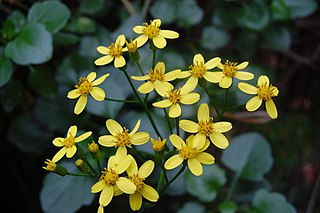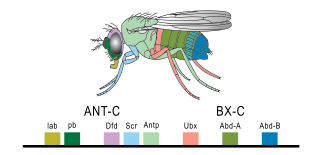Related Research Articles
Monocotyledons, commonly referred to as monocots, are grass and grass-like flowering plants (angiosperms), the seeds of which typically contain only one embryonic leaf, or cotyledon. They constitute one of the major groups into which the flowering plants have traditionally been divided; the rest of the flowering plants have two cotyledons and are classified as dicotyledons, or dicots.

Evolutionary developmental biology is a field of biological research that compares the developmental processes of different organisms to infer how developmental processes evolved.

Evolutionary biology is the subfield of biology that studies the evolutionary processes that produced the diversity of life on Earth. It is also defined as the study of the history of life forms on Earth. Evolution holds that all species are related and gradually change over generations. In a population, the genetic variations affect the phenotypes of an organism. These changes in the phenotypes will be an advantage to some organisms, which will then be passed onto their offspring. Some examples of evolution in species over many generations are the peppered moth and flightless birds. In the 1930s, the discipline of evolutionary biology emerged through what Julian Huxley called the modern synthesis of understanding, from previously unrelated fields of biological research, such as genetics and ecology, systematics, and paleontology.

Floral symmetry describes whether, and how, a flower, in particular its perianth, can be divided into two or more identical or mirror-image parts.

The eudicots, Eudicotidae, or eudicotyledons are a clade of flowering plants mainly characterized by having two seed leaves upon germination. The term derives from Dicotyledons.
Eric Harris Davidson was an American developmental biologist at the California Institute of Technology. Davidson was best known for his pioneering work on the role of gene regulation in evolution, on embryonic specification and for spearheading the effort to sequence the genome of the purple sea urchin, Strongylocentrotus purpuratus. He devoted a large part of his professional career to developing an understanding of embryogenesis at the genetic level. He wrote many academic works describing his work, including a textbook on early animal development.
Evolutionary developmental biology (evo-devo) is the study of developmental programs and patterns from an evolutionary perspective. It seeks to understand the various influences shaping the form and nature of life on the planet. Evo-devo arose as a separate branch of science rather recently. An early sign of this occurred in 1999.

In evolutionary developmental biology, the concept of deep homology is used to describe cases where growth and differentiation processes are governed by genetic mechanisms that are homologous and deeply conserved across a wide range of species.

Gerd B. Müller is an Austrian biologist who is emeritus professor at the University of Vienna where he was the head of the Department of Theoretical Biology in the Center for Organismal Systems Biology. His research interests focus on vertebrate limb development, evolutionary novelties, evo-devo theory, and the Extended Evolutionary Synthesis. He is also concerned with the development of 3D based imaging tools in developmental biology.

Lilioid monocots is an informal name used for a grade of five monocot orders in which the majority of species have flowers with relatively large, coloured tepals. This characteristic is similar to that found in lilies ("lily-like"). Petaloid monocots refers to the flowers having tepals which all resemble petals (petaloid). The taxonomic terms Lilianae or Liliiflorae have also been applied to this assemblage at various times. From the early nineteenth century many of the species in this group of plants were put into a very broadly defined family, Liliaceae sensu lato or s.l.. These classification systems are still found in many books and other sources. Within the monocots the Liliaceae s.l. were distinguished from the Glumaceae.
Ralf Josef Sommer is a German biologist specializing in evolutionary developmental biology.
Alessandro Minelli is an Italian biologist, formerly professor of zoology in the Faculty of Mathematical, Physical and Natural Sciences of the University of Padova mainly working on evo-devo subjects.
Pamela Soltis is an American botanist. She is a distinguished professor at the University of Florida, curator at the Florida Museum of Natural History, principal investigator of the Laboratory of Molecular Systematics and Evolutionary Genetics at the Florida Museum of Natural History, and founding director of the University of Florida Biodiversity Institute.

The extended evolutionary synthesis consists of a set of theoretical concepts argued to be more comprehensive than the earlier modern synthesis of evolutionary biology that took place between 1918 and 1942. The extended evolutionary synthesis was called for in the 1950s by C. H. Waddington, argued for on the basis of punctuated equilibrium by Stephen Jay Gould and Niles Eldredge in the 1980s, and was reconceptualized in 2007 by Massimo Pigliucci and Gerd B. Müller. Notably, Dr. Müller concluded from this research that Natural Selection has no way of explaining speciation, saying: “selection has no innovative capacity...the generative and the ordering aspects of morphological evolution are thus absent from evolutionary theory.”
Scott Frederick Gilbert is an American evolutionary developmental biologist and historian of biology.

The evo-devo gene toolkit is the small subset of genes in an organism's genome whose products control the organism's embryonic development. Toolkit genes are central to the synthesis of molecular genetics, palaeontology, evolution and developmental biology in the science of evolutionary developmental biology (evo-devo). Many of them are ancient and highly conserved among animal phyla.

How the Snake Lost Its Legs: Curious Tales from the Frontier of Evo-Devo is a 2014 book on evolutionary developmental biology by Lewis I. Held, Jr. The title pays homage to Rudyard Kipling's Just So Stories, but the "tales" are strictly scientific, explaining how a wide range of animal features evolved, in molecular detail. The book has been admired by other biologists as both accurate and accessible.

Cassandra Extavour is a Canadian geneticist, researcher of organismic and evolutionary biology, professor of molecular and cell biology at Harvard University, and a classical singer. Her research has focused on evolutionary and developmental genetics. She is known for demonstrating that germ cells engage in cell to cell competition before becoming a gamete, which indicates that natural selection can affect and change genetic material before adult sex reproduction takes place. She was also the Director of EDEN, a National Science Foundation-funded research collaborative that encouraged scientists working on organisms other than the standard lab model organisms to share protocols and techniques.

Paula McSteen is a scientist known for her research on plant genetics. In 2020 she was elected a fellow of the American Association for the Advancement of Science.
References
- ↑ "Barbara Ambrose » New York Botanical Garden". New York Botanical Garden. Retrieved 22 August 2020.
- ↑ "Ambrose, Barbara". www.gc.cuny.edu. Retrieved 22 August 2020.
- 1 2 "Massey University College of Sciences Institute of Molecular Biosciences Annual Report" (PDF). 2008. Retrieved 22 August 2020.
- 1 2 3 4 5 6 7 8 Ambrose, Barbara, Curriculum Vitae
- ↑ Ambrose, B. A.; Lerner, D. R.; Ciceri, P.; Padilla, C. M.; Yanofsky, M. F.; Schmidt, R. J. (2000). "Molecular and genetic analyses of the silky1 gene reveal conservation in floral organ specification between eudicots and monocots". Molecular Cell. 5 (3): 569–79. doi: 10.1016/s1097-2765(00)80450-5 . PMID 10882141.
- ↑ "Google Scholar - Molecular and genetic analyses of the silky1 gene reveal conservation in floral organ specification between eudicots and monocots search". scholar.google.com.
- 1 2 "Ambrose, Barbara". www.gc.cuny.edu.
- ↑ "Design Talk - Garden of Secrets". Cooper Hewitt, Smithsonian Design Museum. 19 June 2019.